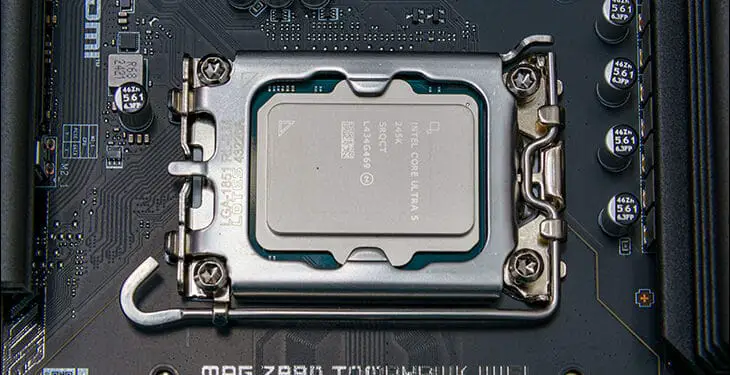For this generation we are not going to spend much time on manual overclocking for the simple reason that the days of needing to overclock a processor to get all the performance it has to offer are pretty much done and buried in the past. These days the CPUs act more like NVIDIA GPUs and ‘overclock’ themselves… kinda… sorta. In reality, Intel and AMD have already done the hard work and know what the frequency ‘sweet spot’ of a given core architecture is… and then gives it to you. Albeit with a few caveats. Namely heat. Use a baked potato and it is never going to unlock its full potential. Use good cooling… and it will. Simple as that.
This is not to say that the Core Ultra 200-series has nothing left in the tank to give experienced overclockers. It is just that things are bit different these days and you will be fighting the law of diminishing returns right from the get go. Even if you don’t care about power consumption and heat output, due to the recent 13 and 14th gen micro-code (and possibly Intel 7nm fab production) issue Intel has locked down the amps the motherboard can feed the processor. So the days of the BIOS easily being able to push above the ICCMax without getting a… phone call from Intel are also gone. Even here Intel has gone back to a more conservative approach to amps they are rated for… as the old adage goes “volts hurt, amps kill” and Intel does not want you to kill your CPU for clicks, clout, or just stupidity.

This is why even though the ICCMax (“the maximum current a processor can draw”… aka MAX POWA) or ICCMax.app (“realistic” power draw at max temp when running ‘real’ applications) numbers have not changed in a noteworthy fashion (347/245 amps) for the Ultra 9 nor Ultra 5 (242/174a) versus the latest 14th gen standards… well that is the latest and greatest ‘refresh’ standards for the 14th gen we are talking about. When released Intel was fine with higher amps being pushed… as even the PL4 (aka PMax, aka absolutely the highest amps allowed before we pull the boards certification) was higher at 400Amps. Furthermore, Intel has… tightened up the wording and given motherboard manufactures zero wiggle room… so the days of 500A are gone.

For example in the Data Sheet for the 14th gen (aka the standards that Intel enforces on motherboard manufactures) “PMax (PL4) is the maximum instantaneous electrical power drawn by the SoC…”. Versus the wording in the Core Ultra 200-series “Power Limit 4 (PL4): A limit that will not be exceeded…”. Thus no more wiggle room.

Tau has also been changed to a hard limit of 448 seconds and a recommended 28 seconds vs. the last gens 56 second recommendation and no enforcement of the 448 second Tau max. So yes. A lot less wiggle room for motherboards manufactures to make their premium boards ‘faster’ via BIOS tricks.
All of which means that if you are manually overclocking you may want, from time to time, to go and check for yourself. After all, the 14th gen numbers did go down. So maybe a ‘sane’ 200-series overclock will suddenly be… not so sane.
So we do strongly encourage you to go and check it out for yourselves here:
https://www.intel.com/content/www/us/en/products/docs/processors/core/core-technical-resources.html

Moving on. Yes, the Integrated Memory Controller is better. It is much better. It is actually a lot better than Intel’s faith in it. After all, while it is indeed true that technically Intel rates the new IMC for DDR5-6400 native speeds… our hunch was is indeed correct and that only pertains to (ironically more laptop and server orientated) CUDIMMs. For UDIMM DIMMS? It’s back to the last gens DDR-5600. However there is some improvement here to be found.
Last gens DDR-5600 was only for ‘1DPC 1R’ (aka “One DIMM Populated per Chanel using single rank RAM”) and it went down to DDR5-5200 for ‘1DPC 2R’ (aka “One DIMM Populated per Chanel using dual rank RAM”) and then frequencies fell off a cliff.
For this gen’s IMC it is DDR-5600 for 1DPC 1R and 1DPC 2R. A major improvement for those big boi 48GB sticks and its 96GB configuration. Of course if you want to really max out the mem with 2 C/UDIMMS per channel and with 2 Ranks per C/UDIMM (e.g. 192GB via 48GBx4) we are still back in the poors seating of the arena with DDR4-4800 (small 1R sticks) or even 4400 (2R). Just like it was last gen. Which is bollocks as this controller can handle 6400 like a champ with four 32GB sticks with nothing more than a ‘set it and forget it’ BIOS adjustment. In both the Core Ultra 9 and Core Ultra 5 we might add. Color us impressed. Still not DDR5-8000 (or the gold… meme… standard above 9000) but a good step in the right direction.
Overall, and to borrow Nietzsche, “God(ly overclocking) is dead. God(ly overclocking for the CPU) remains dead. And we have killed him (with demands for unsustainable generational improvements)!”… but that is not to say that it is not fun. It is and probably always will be. Just expect this generations IMC (when paired with good quality DDR5 sticks) to have a bit more wiggle room than the CPU. In fact, while you can get a couple extra hundy on the E-Cores already boosted speeds (if you really want to), do not expect to even match the overclocking abilities of the last generation on the P-Core. Decoupling or not. Its not in the cards… which in retrospect is a Good Thing™. The 6GHz barrier was called a Great Barrier for a reason, and pushing up to it and past it takes God Level sand. Put another way, if you think you are going to get 6.2 or higher on this gen’s P-Cores at seemingly sane amps (and volts)… well forget about ‘Golden’ and think more along the lines of ‘Platinum’ when it comes to binning chips to find ‘the one’. Which is fine. Few would even notice the difference, and those that do will mostly consist of those who consider it a hobby. One where they will be yanking, yeeting, and replacing every time a new faster CPU is released.









